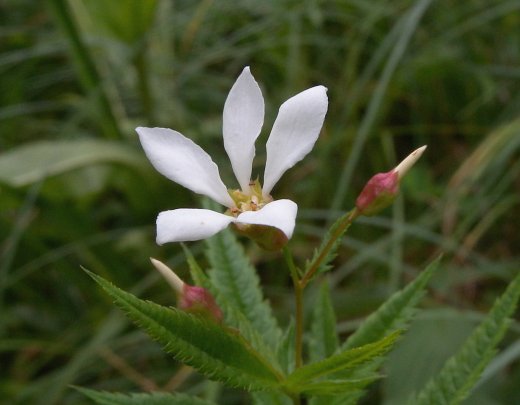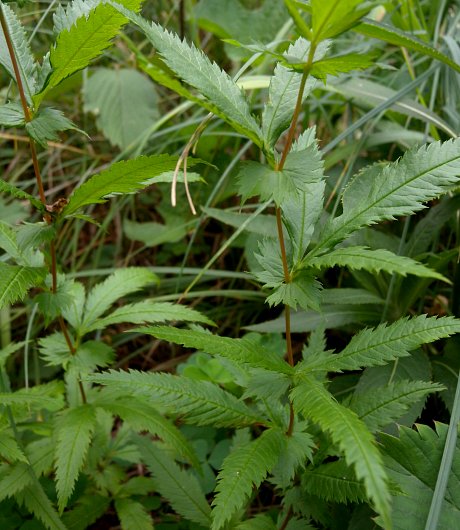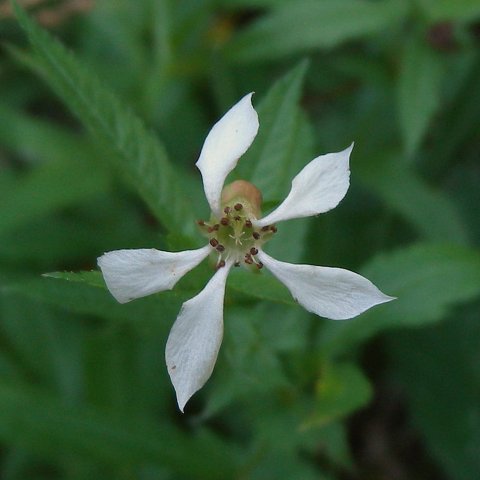
Upper stems terminate in either individual flowers or small cymes of 2-5 flowers. The branches of the cymes and pedicels of the flowers are slender and hairless to sparsely short-pubescent; the pedicels are ½–2" long. Individual flowers are ¾–1¼" across when they are fully open. Each flower consists of a short-cylindrical calyx with 5 upright teeth, 5 spreading white petals, 10-20 stamens, and 5 clustered pistils. The calyx is about ¼" long, light green to red, and hairless to sparsely short-pubescent; its small teeth are triangular in shape. The petals are narrowly elliptic or narrowly oblanceolate-elliptic in shape. The stamens have short filaments and light brown to dark brown anthers. The blooming period occurs from early to mid-summer, lasting about 2-3 weeks. Afterwards, individual flowers are replaced by 5 clustered follicles that are partially exserted from the persistent calyx. Individual follicles are about ½" long, 3-angled-ovoid in shape with slender beaks, and few-seeded; they eventually split open to release their seeds. Mature individual seeds are about 2.5 mm. long, reddish brown, broadly oblongoid-ellipsoid in shape, flattened along one side, and minutely pitted. The root system is fibrous and rhizomatous. During the autumn, the foliage of this plant becomes pinkish yellow or red.

Cultivation: The preference is mesic to dry-mesic conditions, partial sun, and clay-loam, loam, or rocky ground. This wildflower should be cultivated more often.
Range & Habitat: The native American Ipecac (Porteranthus stipulatus) occurs occasionally in the southern half of Illinois, while in the rest of the state it is absent or rare (see Distribution Map). Illinois lies along the northern range-limit of this species. Habitats include upland woodlands, rocky wooded slopes, upland savannas, and limestone glades. Oak trees (Quercus spp.) are usually the dominant canopy trees in these habitats. Occasional wildfires are probably beneficial in maintaining populations of this species. It usually occurs in higher quality natural areas.

Faunal Associations: The nectar and pollen of the flowers attract primarily bees, including Anthophorine bees (Anthophora spp.), little carpenter bees (Ceratina spp.), resin bees (Heriades spp.), mason bees (Hoplitis spp., Osmia spp.), leaf-cutter bees (Megachile spp.), Halictid bees (Lasioglossum spp.), and dagger bees (Calliopsis spp.). Other insect pollinators include nectar-seeking butterflies, skippers, bee flies (Bombyliidae), and thick-headed flies (Conopidae); see Robertson (1929) and Rudolph et al. (2006). The foliage is toxic to mammalian herbivores.
Photographic Location: An upland woodland along Lake Charleston in Coles County, Illinois, and the wildflower garden of the webmaster in Urbana, Illinois.

Comments: American Ipecac (Porteranthus stipulatus) has a distinctive appearance, particularly during the relatively short period when it is in bloom. The stipules of this plant are unusually large in size and persistent. Another similar species, Bowman's Root (Porteranthus trifoliatus), occurs further to the east in the Appalachian Mountains, but it has not been found in Illinois as a native or naturalized wildflower. Compared to American Ipecac, this latter species has much smaller stipules along its stems and they are early-deciduous, rather than persistent. Bowman's Root has flowers with slightly longer petals and a longer cylindrical calyx; the leaflets of this plant are also wider than those of American Ipecac. Both of these plants have been referred to as Indian Physic, and some authorities assign them to the Gillenia genus. Thus, a scientific synonym of American Ipecac is Gillenia stipulata.